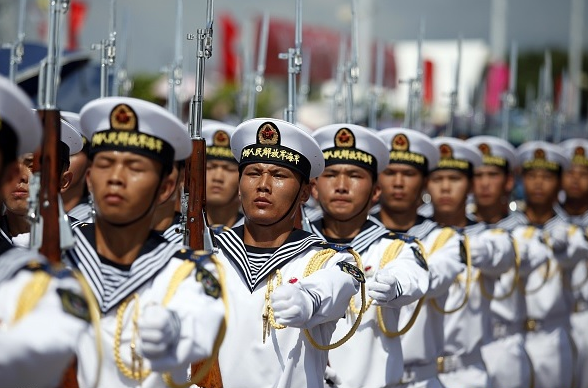
The sustainability of Beijing’s growing power and influence rests on its ability to secure its geopolitical and economic interests, and it is for the realization of these goals that China has adopted an increasingly aggressive policy in the South China Sea. The Permanent Court of Arbitration is set to announce its ruling today on the Philippines’ case against Beijing’s claims in the South China Sea. China responded to the case by launching its largest ever fire drill in the contested waters earlier this week. With China claiming the largest share of territory in the South China Sea, an unfavourable verdict could trigger tension in the already volatile strategic waterway.
Located adjacent to three large economies – China, Japan, and South Korea – the South China Sea is home to the busiest shipping lanes in the world and is integral to China’s national security designs and energy interests. The sea presents a unique opportunity for an “energy hungry” Beijing, and this is yet another reason why China has, time and again, claimed sovereignty over various island chains in the region, calling them an “integral part” of its territory.
The dispute in the South China Sea is a potent threat to peace and stability in Southeast Asia. Given China’s aggressive posturing, overlapping territorial claims in the region can flare up serious tensions, if not an armed conflict, with the United States and other regional stakeholders. The United States has repeatedly advocated freedom of navigation in the contested waters, and while China has not interfered with the movement of merchant ships, it has, on various occasions, issued warnings and denied access to navy ships, fishing boats and oil exploration vessels in areas deemed international waters.
China’s growing adventurism can be attributed to its growing insecurities. Developing alliances in the region, including that of the United States with Japan, the Philippines, and Vietnam, have made China insecure and also isolated on some fronts. China’s coercive diplomacy, in this regard, is a signal for regional stakeholders and their geographically distant but strategically coalesced ally, the United States. China has also been critical of India’s growing engagements with regional stakeholders such as Vietnam and its growing interference in the South China Sea has left Beijing worried, not because India has a substantial stake in the dispute, but because India can use this to leverage against China’s growing interference in the Indian Ocean Region.
While some believe that China’s insecurities are largely territorial, it is Beijing’s energy insecurity that actually drives its aggressive policies in the South China Sea and beyond. At the heart of China’s aggressive policy of expansionism in the region is its eagerness to secure large energy deposits in the South China Sea. This is evident from the fact that disputes involving energy interests have flared more tension in recent times than those not involving energy interests, such as its boundary dispute with India.
Beijing’s adventurism in the South China Sea is not limited to naval scuffles. China’s land reclamation project in the region has added more complexity to the dispute, much to Washington’s displeasure. While China has defined the reclamation activity as “lawful, reasonable and justifiable”, these projects amount to an attempt to assert its illicit sovereignty claims in the South China Sea. The reclaimed land will not only help China in asserting its claims, but also in sustaining military installations and air strips in the disputed maritime zone, thereby extending the scope of its naval operations.
China’s plan of projecting power and influence within the region is part of its multifaceted global policy, and the South China Sea is its first outpost. By asserting sovereignty over this region, China can ensure a free hand in monitoring and controlling access to Sea Lines of Communication (SLOCs) lying not only in the South China Sea, but also in the Indian Ocean. The scope of its naval operations through the Strait of Malacca into the Indian Ocean will increase, helping China’s execution of its ‘String of Pearls’ strategy. Energy flowing through these SLOCs feeds large economies such as Japan and South Korea, and being in control of these oceanic trade links, China can use them to project its power and hegemony in its immediate neighbourhood and beyond.
In a congressional hearing on February 22nd, Admiral Harry Harris warned the lawmakers against China’s hegemonic designs in the South China Sea. “I believe China seeks hegemony in East Asia. Simple as that,” Admiral Harris said while discussing China’s military build-up in the region.
Tensions in the South China Sea are on the rise, and with multiple stakeholders, it is important for China and the United States to have a multifaceted approach for arriving at a constructive solution. The idea of candid exchange, iterated at the recent China-U.S. Strategic and Economic Dialogue (S&ED), and efforts to redefine the bilateral relationship, have not yet materialized. To prevent the South China Sea from becoming the next global flashpoint, it is important to confront China’s aggressive militarization campaign and its growing assertiveness in the region. Since the use of force has always been an unwise decision, regional stakeholders and China should develop a comprehensive, policy-driven framework of Confidence Building Measures. Through cooperative satellite monitoring, effective implementation of the Declaration on the Conduct of Parties in the South China Sea (DOC), maritime cooperation, and restrictions on construction in occupied and unoccupied features, stability and peace will be preserved in Southeast Asia.
***
Image 1: Jay Directo-AFP, Getty
Image 2: Isaac Lawrence-AFP, Getty



